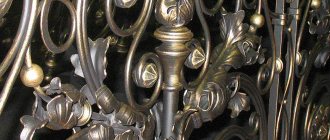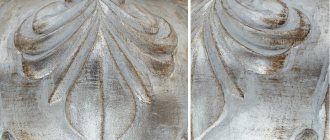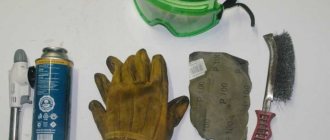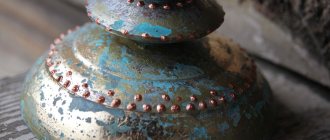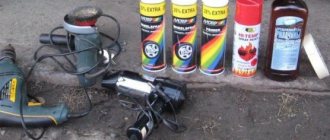Good to know
— How a novice artist can find an order for wall painting — How to choose the right artist on the Internet — How to properly paint a bas-relief on a wall How to use plaster texture in wall painting — How to make an acrylic stretch with your own hands. — How artists can deceive — How to prepare a surface for wall painting — Where and how you can use relief in the interior
LiveInternetLiveInternet
Quote from Nina_Nikishina's message
Read in full In your quotation book or community!
Decorative gilding
Gilding with paint There are ready-made gold paints, which, when applied to a cleaned surface, give the product a golden appearance. The paint consists of a metal powder that reproduces the color of the metal (gold, bronze, copper, iron, etc.). However, paint can only approximately imitate real leaf coating.
1. Acrylic paint is applied to the prepared wooden candlestick as a primer. Red goes better with gold and cool blue with silver. Let the soil dry.
2. Before application, the gold paint is thoroughly mixed with a wooden stick, as the pigments settle to the bottom of the container. A small amount of gold paint is poured into an old saucer and the candlestick is evenly tinted from bottom to top. The paint dries very quickly.
3. To give the candlestick an antique look, after the paint has dried, the “golden” layer is lightly sanded with coarse wool until the red primer layer begins to show through in some places. Taken from: https://remstd.ru/
Framed in gold - gilded leaf
Since ancient times, gilding has been carried out mainly in two ways: by gluing gold leaf onto an object or by fire gilding, based on the use of mercury. The second method of gilding is very dangerous. For example, when the domes of St. Isaac's Cathedral in St. Petersburg were being gilded (1838-1841), about 60 people were poisoned by mercury vapor. Nowadays this method of gilding is not used.
But gilding with gold leaf is widely used today. The word “susal” comes from the ancient word “susal” - face, that is, leaf - facing. Such gold is stored in special books in which 60 pieces of gold with a thickness of 0.13 to 0.67 microns are placed between sheets of paper. Sheet size - 80 x 80, 72 x 20 mm. Other sizes may be available.
Gold leaf can be free and transfer. Free gold is simply a very thin layer of metal. It cannot be touched with your hands; it deflates from breathing, so the gilder manipulates it (transfers, cuts, smoothes) using a special knife and a squirrel brush. In general, considerable skill is required. In transfer gold, each sheet of gold is placed on white silk paper, together with which it is transferred to the surface to be coated. Once the gold is stuck in place, the silk paper can be removed. Transfer gold is much easier to work with.
Gilding
There are two types of gilding with gold leaf: oil (matte) and glue (glossy).
Oil gilding can be used on almost any surface - wood, metal, plaster, plastic. This is a fairly simple, convenient and common method of gilding. This method is called oil-based because the gold leaf is glued onto oil varnish - mordan. The composition of the varnish can be different, it all depends on the conditions in which the gold-plated object will be located.
Adhesive gilding is used only for interior work. This method is used to gild mainly wood, sometimes plastics (polyurethane). The technique of water gilding has remained virtually unchanged since ancient times.
Gold leaf and various types of gold paint can be purchased at art supply stores. We offer transfer gold in different sizes and shades: white gold, yellow gold, 24-karat pure gold. It must be remembered: the purer the gold (the more carats it contains), the less sensitive the gilding will be to the influence of weather and climatic conditions. A material that anyone can purchase to try their hand at gold plating is transfer gold foil.
All that glitters is not gold
A gold-plated product is an expensive thing, not accessible to everyone. The price is mainly high due to the high cost of gold. Therefore, a cheaper replacement was found for gold leaf. One of the well-known substitutes for gold leaf is potal. Potal does not contain precious metals and is the thinnest sheets of a metal alloy - copper with zinc or copper with aluminum. Potal is much cheaper than gold leaf. And it is great for expressing individuality and even momentary mood. The technique of decorating with gold leaf is similar to decorating with gold leaf.
Film gilding
With some stretch, gold self-adhesive film for laser printers, from which stickers and labels on CDs are made, can also be classified as gold leaf. This material is quite accessible to home craftsmen, and working with it is easy. The film is unwound from the roll and gradually glued to the surface. Film gilding is used only on flat surfaces. This is how simple wooden baguettes are gilded, for example. All imitation gold, as well as gold leaf with impurities, are usually coated with a protective layer of varnish.
1. To turn a wooden box into gold, use gold leaf. First you need to apply glue to the base. In this case, acrylic is suitable (it dries quickly).
2. The leaf of gold leaf is glued in its entirety. Since it is thicker than gold leaf, it can be separated by hand and placed on dried glue. The sheets should lie without wrinkles, one on top of the other with a slight overlap.
3. Using a kolinsky brush, the gold leaf is smoothed out and glued to the base with light tapping. Be especially careful when pressing the edges and corners. The excess is picked up on a piece of paper for further use.
4. Since the gold leaf is made of metals such as copper, zinc and aluminum, it oxidizes and darkens when exposed to moisture. Therefore, it is necessary to apply a protective layer of transparent varnish on top. Use shellac or tsaponlac. Bituminous varnish gives gilded items an antique look. After drying, the varnish is polished everywhere, except in hard-to-reach places where a noble patina remains.
Gold and silver sparkles
Metal in the interior is especially relevant today. Even small accessories like boxes, cornices, candlesticks, if given a shiny look, completely change the impression of the apartment. The easiest way to transform them is with metallic glitter or metallic paint in an aerosol can. Working with these materials is interesting, easy and pleasant.
As if by magic, you can literally prepare for Christmas in half an hour. Household items like nuts, pebbles, and shaped pumpkins actually have a wider range of uses than is commonly believed. Especially if the surface, sparkling with gold and silver, is illuminated with candles.
Apply a layer of glue to the box with a brush and, while it is still wet, sprinkle with small glitter. Spread the glitter with your hands, making sure that the surface is covered evenly. A wonderful decoration for a dressing table.
Series of messages “Techniques - Imitations”:
Part 1 - MK on the effect of aging with bitumen varnish Part 2 - Decorative effect of antiquity Part 3 - Decorative gilding Part 4 - Bituminous varnish for aging. Part 5 - Basic techniques for tinting putty... Part 25 - Carrara marble - let's draw it ourselves! Part 26 - imitation of partition enamel Part 27 - Master class "Antique watches using the decoupage technique with an imitation of the effect of oxidized metal"
Question answer
2. How to paint a bas-relief
3. Relief on the wall.
What kind of plasters, clays for modeling. Technique. Ways. Read the answer
Dear Sergey!
I was inspired by your work on the theme “Aquarium” (textured plaster). Please tell me what kind of device you use to create a sea sponge. I would really like to finish my bathroom wall using this technique, but it will be difficult for me to choose a tool myself. Perhaps Did you use something like a tube or syringe? Thank you very much in advance. Best regards, Alla. Read the answer
Hello, Sergey. I haven’t seen such an interesting and informative site, so I was very interested.
I draw well, but with a simple pencil or a fountain pen, in the first grade I was discouraged from using paints, now I have renovated the bathroom and want to do a painting on the ceiling, preferably with acrylic. Please tell me how I can make this drawing, the sequence, the subtleties, I can easily draw it with a pencil, but I would also like the light to come from the picture. I will be very grateful. Read the answer
Gilding of stucco.
At the moment, there are two main types of gilding of stucco:
1. Partial (glare). Often also called artistic. It is used in cases where a moderate effect is needed in order to elegantly emphasize certain elements of stucco decorations. To perform such work, a specialist, in addition to the technique of execution, must have a refined artistic taste.
2. Full gilding. The name speaks for itself. Used to add a luxurious or palace interior.
An excellent addition to decoration is the patination of stucco molding, furniture, metal products, which achieves the effects of aging, craquelure (cracks), etc.
